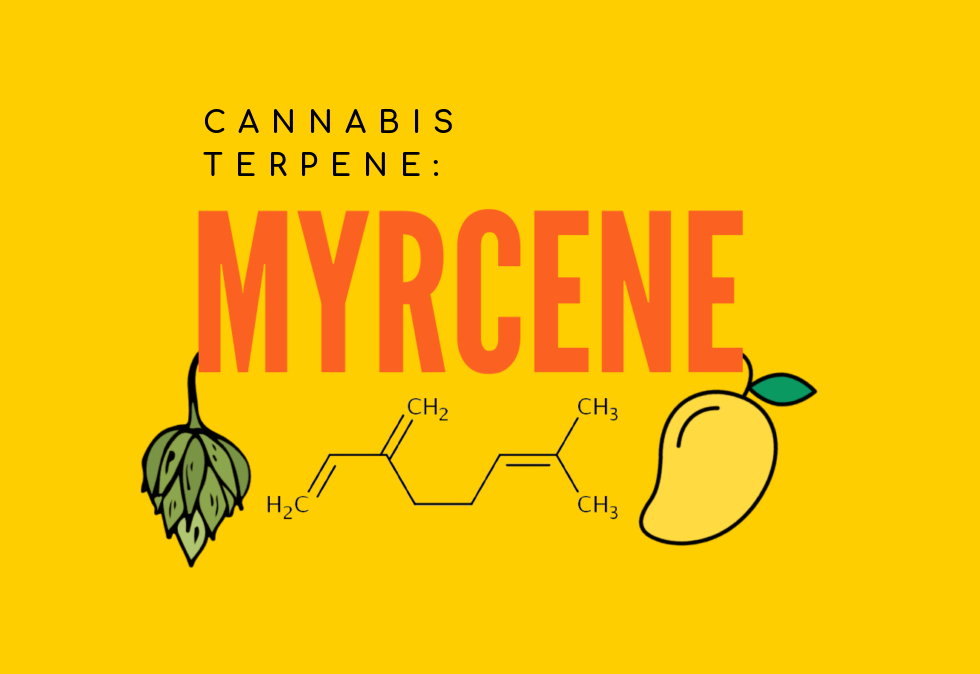All About Myrcene
We’re sure you’re aware of that iconic skunky aroma that we all link to cannabis. In an earlier article, we talked about how terpenes are responsible for the plant’s distinct aroma and taste. They are also shown to have an impact on the experience you get from consuming cannabis as well as contributing to some of the plant’s healing properties. While there are hundreds of cannabis terpenes, myrcene is of the most common ones.
What Exactly is Myrcene?
Myrcene is among the most prevalent terpenes present in cannabis. The terpene is so prevalent that it can be found in roughly 40% of strains. Whether the strain is sativa, indica, or hybrid makes little difference; all three have been shown to have elevated amounts of it. Myrcene is also required for the formation of other cannabis terpenes, such as linalool and geraniol.
Aside from cannabis, myrcene can be found in hops and is responsible for the peppery, spicy, balsam aroma of beer. It’s also found in lemongrass, mangos, and basil
Myrcene and The Mango Theory
An intriguing aspect of myrcene is the “Mango Theory” this is the idea of eating mangos prior to consumption to not only speed up the effects but also optimize the experience. Experts indicate that this assertion is correct and there is science that supports these claims. Myrcene (which is also found in mangos) has been demonstrated to raise the CB1 receptor’s peak saturation level, resulting in a more intoxicating effect.
Most people will feel more intense effects if they eat a fresh mango 45 minutes before consuming cannabis. For the best results, eat the mangos fresh from the fruit rather than just drinking the juice.
How Does Myrcene Work?
Myrcene functions by engaging with the endocannabinoid system of the body. This system controls various bodily processes, including the management of inflammation and pain. It has been demonstrated that myrcene increases the endocannabinoid system’s activity, which may have some positive health effects. Some of the possible health benefits of this terpene are:
- Myrcene for sleep
Herbal remedies that contain myrcene have a rich history of being used in traditional medicine as a sleep-promoting component. Tea with lemongrass and a high myrcene content has been utilized in Mexico as a muscle relaxant and sedative. Germans frequently use myrcene-rich hops products as a sedative. Outside of its uses traditionally, scientific evidence has been able to prove its sedative properties as well.
- Myrcene for pain and inflammation
Due to the claims of myrcene’s pain-relieving effects, Brazilian folk medicine has used lemongrass tea with high myrcene content. In 1990, Brazilian researchers made the first known claim that myrcene lessens pain. It has been contended that myrcene reduces pain by elevating the brain’s and spinal cord’s natural opioid chemicals. Just as with most claims with cannabis, much more research is needed to establish whether myrcene has legitimate pain-relieving and anti-inflammatory properties.
Final Word
Myrcene might be the solution if you’re looking for an organic way to reduce pain or inflammation. It has been demonstrated that myrcene has analgesic properties, which means it can aid in reducing or eliminating pain. Myrcene may also aid in promoting sleep. Fortunately, it is safe and simple to utilize, making it a fantastic choice for those seeking an alternative to conventional medications. However, we always suggest you consult your care provider to ensure it’s a good option for you!
Thanks for reading,

Social Share:


